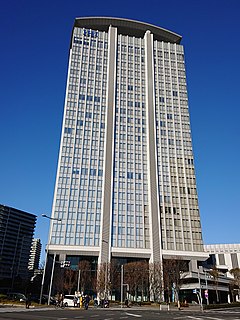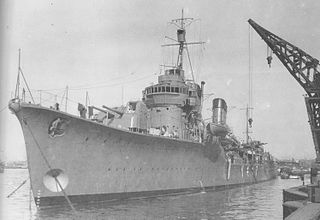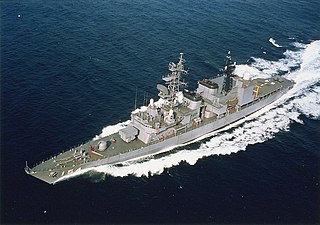Two warships of Japan have borne the name Amagiri:
- Japanese destroyer Amagiri (1930), a Fubuki-class destroyer launched in 1930 and sunk in 1944
- JDS Amagiri, an Asagiri-classdestroyer launched in 1986
Two warships of Japan have borne the name Amagiri:

The naval Battle of Kula Gulf took place in the early hours of 6 July 1943 during World War II. The battle involved United States and Japanese ships off the eastern coast of Kolombangara in the Solomon Islands. It took place during the early stages of the New Georgia campaign when a Japanese force landing reinforcements at Vila was intercepted by a force of US Navy cruisers and destroyers. One US light cruiser was sunk during the engagement while two Japanese destroyers were sunk and two more were damaged. The Japanese withdrew after the engagement, having landed 1,600 troops.

IHI Corporation, formerly known as Ishikawajima-Harima Heavy Industries Co., Ltd., is a Japanese engineering corporation headquartered in Tokyo, Japan that produces and offers ships, space launch vehicles, aircraft engines, marine diesel engines, gas turbines, gas engines, railway systems, turbochargers for automobiles, plant engineering, industrial machinery, power station boilers and other facilities, suspension bridges and other structures.

The Fubuki-class destroyers were a class of twenty-four destroyers of the Imperial Japanese Navy. The Fubuki class has been described as the world's first modern destroyer. The Fubuki class set a new standard not only for Japanese vessels, but for destroyers around the world. They remained formidable opponents to the end of World War II, despite being much older than many of their adversaries.

Amagiri was the 15th of 24 Fubuki-class destroyers, built for the Imperial Japanese Navy following World War I. When introduced into service, these ships were the most powerful destroyers in the world. They served as first-line destroyers through the 1930s, and remained formidable weapons systems well into the Pacific War. She is most famous for ramming the PT-109 commanded by Lieutenant John F. Kennedy, who would later become the 35th President of the United States.

Yūgiri was the fourteenth of twenty-four Fubuki-class destroyers, built for the Imperial Japanese Navy following World War I. When introduced into service, these ships were the most powerful destroyers in the world. They served as first-line destroyers through the 1930s, and remained formidable weapons systems well into the Pacific War.
At least three warships of Japan have borne the name Uranami:
Two destroyers of the Imperial Japanese Navy were named Minazuki or Minatsuki 水無月 :
Three destroyers of Japan were named Nagatsuki:
Three destroyers of Japan have borne the name Kikuzuki or Kikutsuki:
Two destroyers of the Imperial Japanese Navy were named Mikazuki:
At least three warships of Japan have borne the name Isonami:
Two Japanese warships have borne the name Ushio:
Two destroyers of the Imperial Japanese Navy were named Umikaze:
Two destroyers of the Imperial Japanese Navy were named Yamakaze:

JS Amagiri (DD-154) is an Asagiri-class destroyer of the Japan Maritime Self-Defense Force. Amagiri is currently in active service, homeported in Maizuru, Kyoto, Japan.
At least four warships of Japan have borne the name Atago:
Two Japanese destroyers have been named Enoki:
At least three warships of Japan have borne the name Maya:
Three Japanese destroyers have been named Akizuki:

JS Hamagiri (DD-155) is an Asagiri-class destroyer of the Japan Maritime Self-Defense Force.